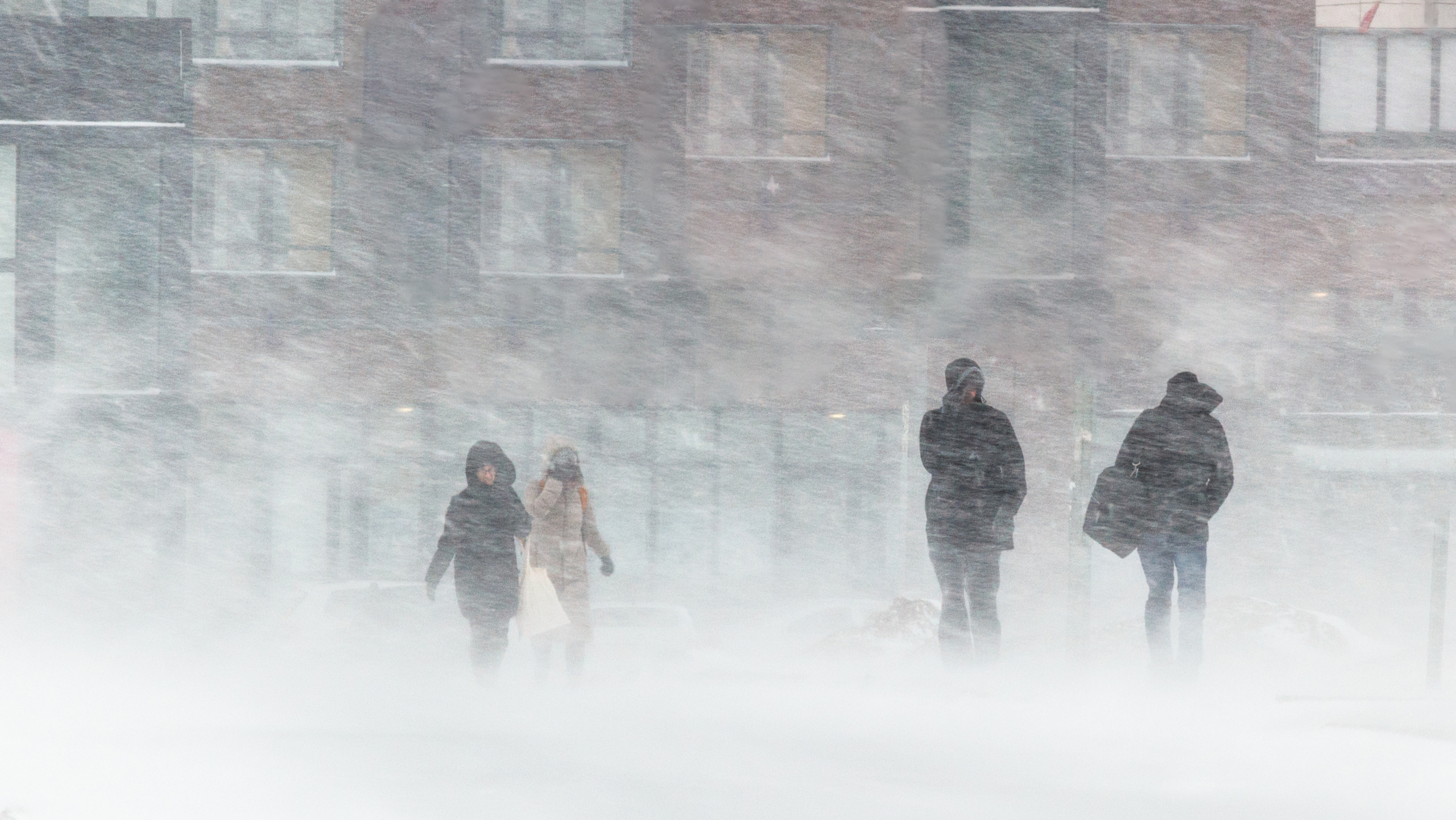The Guide to Commercial Winter Storm Restoration
Winter weather is near, and colder temperatures bring a greater need for awareness surrounding potential property damage and the challenges it can present. Depending on the type of damage, property owners and managers are faced with potentially endangering the lives of their building’s occupants and a period of downtime that puts business at risk.
Seasonal property damage affects everyone, regardless of geographic region. Areas typically hit with snow run into a myriad of issues, but these properties were built with material that keeps the changing seasons in mind. Places with warmer temperatures that don’t historically get hit by snowfall are now faced with unpredictable weather and building materials that cannot withstand the events that occur.
To many, restoration is seen as the reaction to the disaster, but this is far from the truth. Here, we’ll provide a complete overview of commercial winter storm damage restoration, with professional tips on how you can prepare, react and come back from a major winter weather event.
Why Winter Preparedness Is Crucial for Commercial Properties
Winter weather doesn’t just bring a chill in the air; it brings a chill to your bottom line if you’re not prepared. The costs associated with winter-related damage can be astronomical. From water damage due to burst pipes, to business interruption because of power outages, the financial toll can be devastating. Moreover, the risks aren’t just financial; they’re operational and reputational. A single winter storm can disrupt your operations for days or even weeks, affecting your standing with clients and stakeholders.
Advanced planning is not just a precaution; it’s a necessity. By identifying potential risks and implementing preventive measures, you can significantly mitigate property loss and operational downtime. This is not just about surviving the winter; it’s about thriving through it.
Don’t Wait for Winter To Strike! Winter weather can be unpredictable. Be prepared, and mitigate risks that could affect your bottom line. Speak with First Onsite today.
Preventing Winter Storm Damage to Commercial Properties
At First Onsite, we believe in the power of preparation. Our dedicated teams are trained to assess your property’s readiness for winter and recommend targeted interventions. From sealing gaps in the insulation, to ensuring your heating systems are up to the task, we cover all bases. By identifying vulnerabilities in your property and addressing them before winter sets in, you can significantly reduce the risk of damage.
Understanding The Commercial Property
It’s important to have a baseline of knowledge about a property so it can properly be prepared for seasonal weather.
Age and Materials
The age of your commercial property is more than just a number; it’s a clue to the types of materials used in its construction and their current condition. Older buildings may have been built with materials that are less resilient to the harsh conditions of winter, such as certain types of insulation that degrade over time or older plumbing systems more prone to freezing. Understanding the age and materials of your property can guide your winter preparedness efforts, helping you identify areas that may need reinforcement or special attention.
Deferred Maintenance*
Deferred maintenance refers to the practice of postponing necessary repairs or upgrades on your property. While this might save money in the short term, the long-term risks are significant, especially during winter. For instance, a neglected roof leak can become a major issue when snow and ice accumulate, leading to potential structural damage and costly repairs. Similarly, ignored HVAC issues could result in heating failures during the coldest days of the year. Addressing these maintenance tasks before winter sets in can prevent minor issues from becoming major disasters.
*This term refers to the practice of postponing necessary repairs or upgrades to your property. While it might save money in the short term, the risks can be significant, especially during winter.
Grading outside the Property*
The grading or slope of the land surrounding your property can significantly impact how well it fares during winter weather. Poor grading can lead to water pooling around the foundation, which can freeze and cause foundational cracks. Even if water doesn’t enter the building, the freeze-thaw cycle can weaken the structural integrity over time. Therefore, it’s crucial to assess the exterior grading and make necessary adjustments before winter arrives. This might include re-sloping the land, installing drainage systems, or applying sealants to vulnerable areas.
*The term ‘grading’ refers to the slope or incline of the land surrounding your property. Poor grading can lead to water pooling around your foundation, which can freeze and cause foundational cracks.
Roof and Ceilings
The condition of your roof and ceilings should not be overlooked. Ice damming, a common winter phenomenon, can occur when snow melts and refreezes at the edges of your roof, potentially causing leaks and structural damage. Regular inspections can help you catch any signs of wear and tear that could exacerbate winter damage. This is also an excellent time to assess the insulation in your attic or roof, as adequate insulation can prevent heat loss and reduce the risk of ice dams.
By taking the time to thoroughly understand these aspects of your commercial property, you’re laying the groundwork for an effective winter preparedness plan. Knowing what you’re working with allows you to take targeted, effective actions that can save you significant time and money when winter storms hit.
Regional Winter Weather Awareness
How winter affects a property is determined in part by region. Commercial properties in Canada will see buckets of snow, while the western United States will see slightly colder temperatures and occasional precipitation. Northeastern communities in the US will see sub-zero temperatures and the potential for freezing rain. Understanding the type of weather a property will encounter determines the types of risks that are to be expected. However, in recent years there have been exceptions.
Some scenarios aren’t as cut and dry. When freezing temperatures hit Texas in 2021, the state suffered from widespread power outages. This led to a variety of issues that ranged from burst pipes to unorthodox heating methods, which caused some to suffer from carbon monoxide poisoning, and in some cases even death. The state’s freeze incident wasn’t expected or prepared for. Winter weather events can differ from year to year, but the hazards faced are similar.
Every property is different. Get a tailored winter preparedness plan that accounts for the age, materials and unique features of your property.
Get a Customized Preparedness Plan, Now!

Manage Commercial Buildings for a Winter Storm
Whether it’s in Texas or Ontario, winter weather can strike without warning. Which is why it’s important to identify and resolve issues before they become a problem. Early detection always results in dollars saved. Our winter preparation checklist can act as a guide for property owners and managers to kickstart seasonal thinking before it’s too late.
Winter Prep Checklist for Property Owners
Use this checklist to keep buildings safe season after season.
- Building Access
- ☐ Ensure all entrances and exits are clear of snow and ice.
- ☐ Stock up on ice melt and sand for walkways and parking lots.
- ☐ Check the functionality of automatic doors and backup power for key card systems.
- Pipes and Meters
- ☐ Pipes and meters can freeze when in unheated areas. Ensure there is proper insulation in the surrounding area and/or a local heat source is operative.
- ☐ Locate and label water shut-off valves.
- ☐ Turn off water to outside hose bibs, remove hoses and drain the pipes.
- ☐ Regularly monitor water meters for unusual activity that could indicate a leak.
- Roofs
- ☐ Inspect for loose shingles or tiles that could become hazards in strong winds.
- ☐ Clear gutters and downspouts to allow for proper drainage.
- ☐ Evaluate the weight-bearing capacity of the roof for snow and ice accumulation.
- ☐ Remove snow from roofs regularly during winter season to avoid heavy snow load.
- Seal Openings
- ☐ Check windows and doors for drafts and seal as necessary.
- ☐ Inspect and seal any openings in the building envelope, including utility entrances.
- ☐ Seal all openings where cold air can enter with caulking and insulation to reduce exposure of cold air to plumbing lines and prevent energy loss.
- Unoccupied Spaces
- ☐ Establish a routine for inspecting unoccupied space on a daily, weekly, or monthly basis.
- ☐ Maintain a minimum temperature to prevent freezing in unoccupied spaces.
- ☐ Use timers or smart systems to manage heating in these areas efficiently.
- Generators, Boilers, and HVAC
- ☐ Test backup generators and ensure they are fuelled.
- ☐ Contact your preferred service provider to inspect boilers and HVAC systems for efficiency and safety.
- ☐ Replace air filters and clean ducts to improve air quality and system efficiency.
- Fire Hydrants
- ☐ Coordinate with your local fire department to mark hydrants above the snow line near your business for ease in locating, and check the pressure and functionality of hydrants as part of routine maintenance.
- ☐ Ensure fire hydrants are accessible and not blocked by snow or debris.
By following this comprehensive checklist, you can significantly reduce the risk of winter-related damage to your commercial property. Each item on this list is designed to address the most common issues that arise during the winter months, providing you with a roadmap for effective winter preparedness.
Building Your Commercial Property Emergency Preparedness Plan
Preparing for winter can be an overwhelming experience for anyone, and that’s why it’s encouraged for property owners and managers to get in touch with a disaster restoration company.
An emergency preparedness plan is not just a document; it’s a lifeline in times of crisis. Creating a detailed plan that includes roles, responsibilities, and action steps can make the difference between a minor inconvenience and a major catastrophe. The plan should be readily accessible and regularly updated to adapt to changing conditions and risks.
First Onsite’s Pre-Loss Partnership is designed to offer businesses a rapid and effective response in emergencies. By enrolling in the partnership, you ensure that you are top priority for emergency response, minimizing downtime and maximizing safety. This plan is a testament to First Onsite’s commitment to excellence and service, ensuring that you can restore, rebuild and rise, no matter what challenges winter brings.
Want to learn more about winter storm preparation? Check out our Emergency Response Planning services.
First Onsite is The Complete Solution to Overcome Property Damage
First Onsite is your trusted, full-service disaster restoration and reconstruction company, serving the United States, Canada, and beyond. We partner with you to prepare for the threat of catastrophe and to be the first team on-site immediately after disaster strikes.
Our team in your area is backed by national resources, and we scale to meet the needs of your property regardless of size. We have the experience to respond to your property needs while keeping a close eye on environmental changes that could affect you in the future. We stay a step ahead of disaster so you can too.
We are on call 24 hours a day, 365 days a year, and you can request our services at any time.
Turn Your Preparedness Plan into Action
A good plan is only effective when implemented. Partner with First Onsite to ensure your top priority for rapid and effective emergency response.
Enroll in First Onsite’s Pre-Loss Partnership Today!
